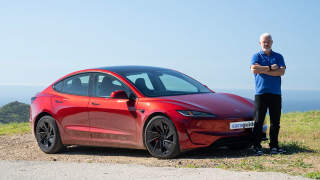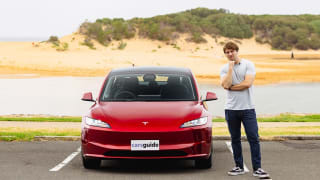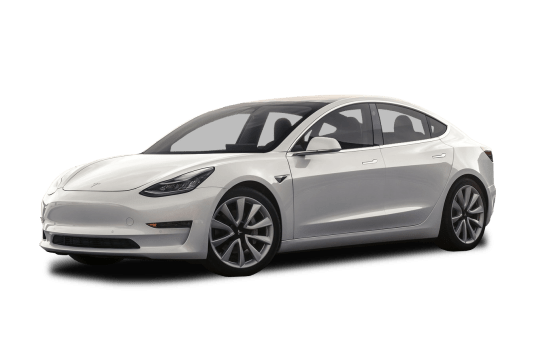
What's on this page
Tesla Model 3 2024
Carsguide Senior Journalist Tom White had this to say at the time: The Model 3 is a masterwork. It’s faster than pretty much anything else on the road, it retains mind-bending, physics-defying handling and as usual, some of the best software on the car market right now.
You can read the full review here.This is what Tom White liked most about this particular version of the Tesla MODEL 3: Ruthless speed, Physics-defying handling, The last word in car software
The Tesla MODEL 3 Sedan competes with similar models like the Toyota Camry, Volvo S60 and Mercedes-Benz A-Class in the Under $60k category category.
The Tesla MODEL 3 is also known as the Code name: BlueStar in markets outside Australia.
Tesla Model 3 2024 News

Tesla's most impressive car yet? 2025 Tesla Model 3 Long Range Rear-Wheel Drive arrives with even more range and efficiency to battle the BYD Seal and Hyundai Ioniq 6, but will it come to Australia?

Move aside, Tesla: Hyundai and Kia's electric cars are the new cultural benchmark | Opinion

More bad news for Chinese electric car makers: Canada to impose huge tax on Chinese EVs such as the 2025 BYD Atto 3, MG4 and even some Tesla Model 3s

Has Tesla peaked? Why the electric brand may be running out of charge - and what it can do to fix it as cars such as the BYD Seal, MG4 and Kia EV6 threaten its dominance | Analysis
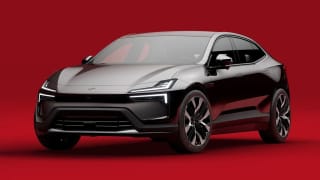
Best electric cars arriving in 2024
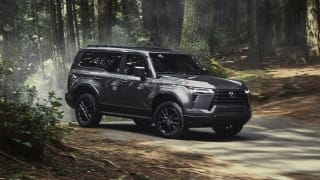
The best new cars coming in 2024

The cars driving China's dominance: The top 5 best selling Chinese-built cars in Australia and how many we've bought
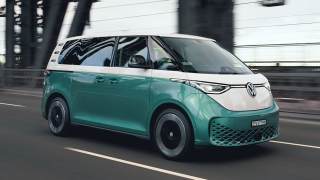
Best hatchback, sedans and people movers arriving in 2024

Is this the biggest barrier to electric car adoption? Why price cuts to the Tesla Model Y, Tesla Model 3, Ford Mustang Mach-E, GWM Ora and Peugeot e-2008 show prices are too high | Opinion
Tesla Model 3 2024 Price and Specs
Pricing guides

| Tesla Model 3 | Body Type | Specs | Price | |
|---|---|---|---|---|
| Long Range | Sedan | — Electric 1 SP AUTO | $71,900 | |
| Performance | Sedan | — Electric 1 SP AUTO | $80,900 | |
| Rear-Wheel Drive | Sedan | — Electric 1 SP AUTO | $61,900 | |
Tesla Model 3 2024 Interior
The Model 3 received an upgraded interior for the 2024 model year, with increased soft-touch materials, new fabric highlights and ambient interior lighting. The minimalist theme continues, with a 'stalkless' steering column and massive 15.4-inch central touchscreen.

Tesla Model 3 2024 Colours
There are five colour choices for the Model 3, white, black, blue, grey, and red. The interior can also either be chosen in either black or white.
- Peal White
- Solid Black
- Deep Blue
- Stealth Grey
- Ultra Red
Tesla Model 3 2024 Range
The Model 3 can travel 513km measured to the WLTP standard in base Rear Wheel Drive form, or 629km for the Long Range.
Tesla Model 3 2024 Accessories
Standard items on the base Rear Wheel Drive include LED headlights, 18-inch alloy wheels with aerodynamic covers, a 15.4-inch central touchscreen, dual wireless chargers, always online connectivity with built-in navigation and matching phone application, ambient interior lighting, synthetic leather interior trim, six-way power adjust for front passengers with heating and ventilation, and heated outboard rear seats.

Tesla Model 3 2024 Dimensions
Dimensions for the 2024 Tesla MODEL 3 are dependent on which body type is chosen. The maximum width and height is 2089mm x 1441mm and can vary on the basis of model.

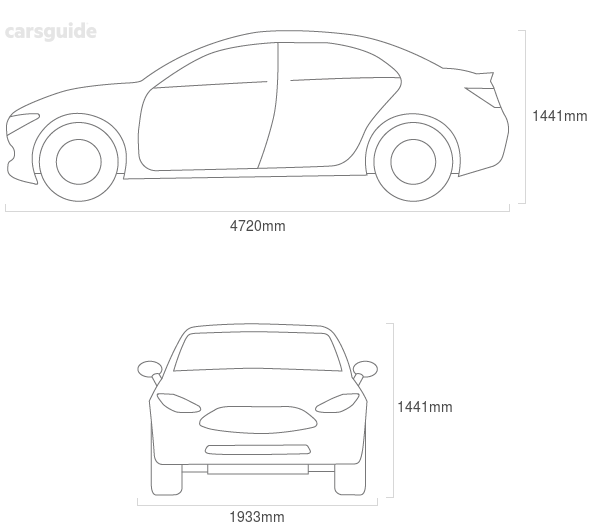
| Tesla MODEL 3 | Body Type | Height x Width x Length | Ground Clearance | |
|---|---|---|---|---|
| Rear-Wheel Drive | Sedan | 1441x1933x4720 mm | 138 mm | |
| Long Range | Sedan | 1441x1933x4720 mm | 138 mm | |
| Performance | Sedan | 1431x2089x4724 mm | 115 mm | |
Tesla Model 3 2024 Speed
The Model 3 can accelerate from 0-100km/h in 6.1 seconds in base Rear Wheel Drive form, or 4.4 seconds for the all-wheel drive Long Range.
Tesla Model 3 2024 Wheel size
Wheel size for the 2024 Tesla MODEL 3 will vary depending on model chosen, although keep in mind that many manufacturers offer alternate wheel sizes as options on many models.The wheel size available will alter the range of tyres available to be fitted.
| Tesla MODEL 3 | Body Type | Front Tyre Size | Front Rim | Rear Tyre Size | Rear Rim | |
|---|---|---|---|---|---|---|
| Rear-Wheel Drive | Sedan | 235x45 R18 9 | — | 235x45 R18 9 | — | |
| Long Range | Sedan | 235x45 R18 9 | — | 235x45 R18 9 | — | |
| Performance | Sedan | 235x35 R20 | — | 275x30 R20 | — | |
Tesla Model 3 2024 Boot Space
The Model 3 has a boot capacity of 594 litres, although this includes the under floor storage and large side storage areas behind the wheel arches. It also has an 88-litre frunk for additional storage.
Tesla Model 3 2024 Q&As
Check out real-world situations relating to the Tesla MODEL 3 here, particularly what our experts have to say about them.
-
How do Tesla cars work?
It’s a popular barbecue or front bar topic of discussion: How do Tesla cars work? Fundamentally it’s pretty simple; they work like any other car, but they use an electric motor in place of an internal combustion engine. And instead of filling them with petrol, you recharge the batteries with electricity. There are other differences, too, but that’s the simplest definition of what is a Tesla, and the one that allows it to operate on fully renewable energy on some cases.
Tesla is a company founded by Elon Musk, the same guy that invented PayPal. So the company has plenty of money behind it. As well as cars, Tesla makes home storage batteries (for storing rooftop solar power) and is investing in all sorts of renewable technology and electrical components.
Over time, the Tesla cars product has evolved from a small sports car converted to electric, to clean-sheet designs for modern electric cars, SUV, pick-ups and even a semi-trailer than runs on electricity. But which ever Tesla you’re talking about, they all use a common philosophy.
That starts with a battery. In the case of Tesla’s current designs, that’s the latest lithium-ion battery tech. Connected to that is either a single electric motor or a pair of motors that power either the rear wheels or all four wheels respectively. Just like a slot car, you feed power to the electric motor and the car moves. Of course, a slot car doesn’t carry a battery, it picks up its power form the track it runs on, but even that could be a thing of the future for electric cars which might be able to wirelessly collect power through the road surface. It’s not as far off as you might think.
Other differences between a Tesla (and any other mainstream electric car) and a conventional car as we know it include bakes that recoup energy as the car slows (which is used to recharge the battery on the run) and the electrification of every system that is handled mechanically by a conventional car (brake boosting, power steering, heating etc).
Another major difference is that the Tesla drivetrain doesn’t feature multiple gears in its transmission. Because the electric motor offers maximum torque from standstill, the Tesla only needs one gear to achieve lots of acceleration and ample top speed.
The electric motor these days is a pretty neat piece of gear and is virtually maintenance free. It also has the potential to last a lot longer than an internal combustion engine. The batteries are also much better these days and as well as being vastly more energy-rich (their output per kg) they charge more quickly and battery life can easily be half a million kilometres. Some car-makers now offer a ten-year warranty on battery-packs. Tesla in Australia offers up to eight years battery warranty (depending on the model) but, crucially, up to 240,000km of cover guaranteeing that the battery will retain at least 70 per cent of its original capacity at that point.
Perhaps Tesla’s biggest claim to fame is that it took electric cars from golf carts to a product that was sexy and in demand. The company was way ahead of the curve in this regard, but now it seems the rest of the world is catching up, and the Tesla car has more serious competition now than it ever did.
Show more -
Where is Tesla made?
While the city of Detroit, Michigan is the cradle of the North American car industry, electric-car maker Tesla has always marched to the beat of its own drum. So even though it’s a US based entity, Tesla’s worldwide view and its inherent mould-breaking attitude means that its factories are in some interesting locations. But how many are there and in which countries?
Tesla currently has three giant plants across the USA, as well as a plant in China. Some of these plants make the Tesla cars we’re familiar with, while others are responsible for battery and solar technology production. Tesla is also building a fourth North American plant as well as a European gigafactory in Germany, while rumours of a second Chinese plant are also doing the rounds.
Given that Tesla cars are the brand’s most visible, recognisable products, the question usually revolves around where are Tesla cars made? In that case, the answer is the firm’s original gigafactory in Fremont (near San Francisco in California) which builds the Tesla Model S, Model X, Model 3, Model Y as well as components for other Tesla products. The original gigafactory in Fremont is a huge facility (as are all Tesla factories) employing something like 10,000 people. It was once the site of a General Motors manufacturing plant and then a Toyota/GM joint production facility.
The Shanghai plant in China, meanwhile, is the other half of the answer to 'where are Tesla cars built'. That plant produces whole cars, including the Model 3 and Model Y and is slated to produce the forthcoming Telsa Pick-Up which has been pushed back to 2022 at the earliest.
Tesla’s plant in Sparks, Nevada (Near Reno) is largely a battery factory with production of batteries for Tesla cars as well as its Powerwall home-storage battery. The Sparks plant is also a motors factory, producing the electric motors that power Tesla vehicles. The Tesla Semi (delayed but due soon) is also expected to be built at the Nevada plant.
Another Gigafactory is located in New York state, in the city of Buffalo. This concentrates on assembly of solar cells and modules as well as the superchargers that allow Tesla vehicles to be charged quickly in the field.
The factory under construction in the USA now is located at Austin, Texas and will be used to built the Model 3, Model Y and the Pick-Up. The new factory in Berlin, meanwhile, is very close to completion and will initially be used to build the Model Y.
Tesla has always been a brand surrounded by rumours, and these days, these seem to involve a second Chinese plant. The company has also established an Indian business unit, suggesting that a gigafactory on the sub-continent might also emerge.
Show more -
What is the ordering process for a Tesla Model 3?
Tesla certainly does things differently, starting with the cars themselves and extending right throughout the entire purchasing and ownership experience. Basically, Tesla has no dealerships per se, so, to buy a brand-new Tesla you go to the website, create an online account, design the specifics (options and colours) of the car you want and then place your order. And it’s all done electronically.
You then have three days to make any changes to the car’s specification, after which it’s pretty much locked down and Tesla will have begun assembling the bits and pieces that you’ve ordered. It’s after this three-day period that you’ll actually talk to a Tesla employee, who will guide you through the paperwork, payment options and delivery details.
In a way, it’s no different to any other form of online shopping but it does presume that Tesla buyers are also internet savvy enough to trust this process. After all, we’re not talking about pocket-money here, are we?
Show more -
What electric car should I buy?
We can understand your feelings about the centrally-mounted screen in the Tesla, though you do get used to it surprisingly quickly.
As for the other models you’ve mentioned, we’ve had to get the crystal ball out to attempt to answer you!
The Polestar 2 will be on sale by the end of 2020, if all goes to plan. The company will be pushing hard to make that happen.
The VW ID3 is likely not going to be here until 2021, likely the mid or latter part of that year. It certainly has a lot of potential, and with pricing set to start below $50,000, it could well be The People’s (Electric) Car.
There are other options coming, though it depends on your diary and your budget.
You could consider the Tesla Model S, which may have been around for a while, but that also means it has a more traceable reliability history. It has a digital instrument cluster in the regular spot as well.
Have you looked at the Jaguar i-Pace? It has a claimed range of 470 kilometres, though it is on the pricey side of the equation, starting from about $125,000.
Indeed, a high price tag is a common theme among those EVs with big battery capacity and expansive driving range, because you’re basically covering the cost of the batteries with your money.
For instance, there’s the Audi e-tron quattro, which is due here in early 2020. That model will have a range of “more than 400 kilometres”, and - we suspect - a price tag above $120,000.
The Mercedes EQC is about to go on sale, too. Range for that mid-size SUV is pegged at about 450 kilometres, but again, you can expect a high price tag.
If 2021 isn’t too long to wait, there’s the Volvo XC40 Recharge coming then. Based on our previous experience with Volvo XC40s, it’ll be a great small SUV, with predicted range of 400km - though we think that’s understating it, because it has a 78kWh battery pack, and it has AWD too.
At the more affordable end - though admittedly still not quite meeting your expectations for range - there’s the very impressive Hyundai Kona Electric, which has a WLTP range of 449km, and a price tag of around $65k. It isn’t all-wheel drive though.
And MG is about to launch a real upstart in the segment, with the ZS EV hitting showrooms soon for $46,990 drive-away, albeit with a range of 262km. It’s also FWD only.
The Mini Cooper SE will also arrive in mid-2020, with pricing set to be less than $60k. But again, a range of 270km will likely rule it out for your needs, and its 2WD as well.
Another new small EV due next year is the Mazda MX-30. Pricing is still to be confirmed, and range isn’t great at about 300km. It’s FWD too.
In short, at this point in time - and out towards the end of 2020 - it looks like you’ll either need to spend a big amount of money on a premium EV to get the best range possible, or you’ll have to get used to the Model 3’s screen. You could always get an aftermarket head-up display fitted…
Show more
Tesla Model 3 2024 Engine
The Model 3 Rear Wheel Drive has a 208kW/350Nm electric motor on the rear axle, while the Long Range adds a second motor for a combined output of 366kW.
Tesla Model 3 2024 Seats
The Tesla Model 3 is a five-seater, with synthetic leather interior trim, six-way power adjust with heating and cooling for the front two passengers, and heated outboard rear seats.

Tesla Model 3 2024 Fuel consumption
Fuel consumption for the 2024 Tesla MODEL 3 is dependent on the type of engine, transmission, or model chosen. The Tesla MODEL 3 is available with the following fuel type: Electric.
| Tesla MODEL 3 | Body Type | Specs | Fuel Consumption | |
|---|---|---|---|---|
| Long Range | Sedan | Electric,1 SP AUTO | — | |
| Performance | Sedan | Electric,1 SP AUTO | — | |
| Performance | Sedan | Electric,1 SP AUTO | — | |
| Rear-Wheel Drive | Sedan | Electric,1 SP AUTO | — | |
| Rear-Wheel Drive | Sedan | Electric,1 SP AUTO | — | |



